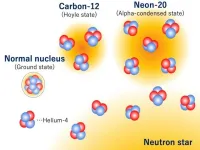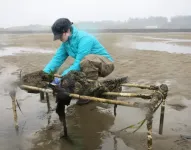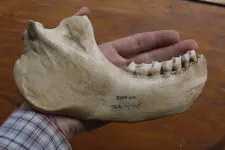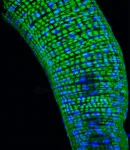Coincidence? I think so: researchers use phylogenetics to untangle convergent adaptation in birds
2021-06-24
(Press-News.org) Researchers from Skoltech and their colleagues have shown that adaptation to similar environments hardly involves similar genomic positions when species are distantly related. The team investigated recurrent adaptations of wildlife birds' mitochondria to high altitude, migration, diving, wintering, and flight. Repeatable substitutions are rather a coincidence than adaptation, which confirms the scientific opinion that distant species "choose" different ways of similar trait evolution. The paper was published in the journal Genome Biology and Evolution.
If an organism wants to survive in unusual conditions, such as oxygen starvation typical for high altitudes or elevation of metabolism rate due to extreme temperatures, it has to adapt. If different species meet similar environment conditions, they will adapt independently and could even do it by same substitutions in identical genomic positions - this is called single-position molecular convergence.
"Convergent evolution is one of most fascinating topics of evolutionary biology: from a practical point of view, it helps to find particular genomic positions associated with adaptation; from a more theoretical one, it shows how repeatable evolution is. Yet detection of adaptive convergent single-position mutations is known to be hard, especially in phylogenetically distant species: scientists continue to argue about whether it is possible at all," Skoltech PhD graduate Valentina Burskaia says.
Burskaia, Professor Georgii Bazykin and their colleagues designed an unusually large dataset of 415 species in which similar traits appear independently dozens of times. The dataset allowed them to examine the problem deeply, as previous attempts to detect convergent single-nucleotide mutations in phylogenetically distant species were often limited by few numbers of convergent phenotype acquisitions.
"Mitochondrial genome was chosen for the study as it is small and thus sequenced for many species, yet full of extremely important genes. Mitochondrial genes are responsible for hypoxia and metabolism level tuning: this guided our selection of phenotypic traits of interest," Burskaia notes.
The team looked at birds who live at high altitudes and diving birds (likely to face hypoxia). To study adaptations which affect metabolism rate changes, scientists considered four groups of species: birds with outstanding flight abilities, long-distance migrants, flightless birds and wintering birds. By running powerful phylogenetic methods, where species are placed on a "tree" and coincident changes in phenotype and genotype are counted, the researchers were able to show that the majority of convergence events can be explained by random coincidences rather than adaptation.
The study, being conceptually close to recent attempts to search for single-position convergences in echolocating bats and marine mammals, confirms that evolutionary landscape at between-order distances is too different for single-position adaptive convergence.
Other organizations involved in this research include Lomonosov Moscow State University, Kharkevich Institute for Information Transmission Problems of the Russian Academy of Sciences, and Hong Kong University of Science and Technology.
INFORMATION:
Skoltech is a private international university located in Russia. Established in 2011 in collaboration with the Massachusetts Institute of Technology (MIT), Skoltech is cultivating a new generation of leaders in the fields of science, technology and business, is conducting research in breakthrough fields, and is promoting technological innovation with the goal of solving critical problems that face Russia and the world. Skoltech is focusing on six priority areas: data science and artificial intelligence, life sciences, advanced materials and modern design methods, energy efficiency, photonics and quantum technologies, and advanced research. Web: https://www.skoltech.ru/.
ELSE PRESS RELEASES FROM THIS DATE:
2021-06-24
Osaka, Japan - Scientists from the Department of Physics and the Research Center for Nuclear Physics (RCNP) at Osaka University, in collaboration with Kyoto University, used alpha particle inelastic scattering to show that the theorized "5α condensed state" does exist in neon-20. This work may help us obtain a better understanding the low-density nucleon many-body systems.
All elements besides hydrogen and helium must have been fused inside the nuclear furnace of a star. The yield during these reactions of carbon-12, which has six protons and six neutrons, is increased by an ...
2021-06-24
Early in the pandemic, it was expected that satellite imagery around the world would show cleaner air as a result of COVID-19 lockdowns. But not all pollutants were taken out of circulation. For tiny airborne-particle pollution, known as PM 2.5, researchers using NASA data found that variability from meteorology obscured the lockdown signals when observed from space.
"Intuitively you would think if there is a major lockdown situation, that we would see dramatic changes, but we didn't," said Melanie Hammer, a visiting research associate at Washington University in St. Louis who led the study. "It was kind of a surprise ...
2021-06-24
Tooth loss is often accepted as a natural part of aging, but what if there was a way to better identify those most susceptible without the need for a dental exam?
New research led by investigators at Harvard School of Dental Medicine suggests that machine learning tools can help identify those at greatest risk for tooth loss and refer them for further dental assessment in an effort to ensure early interventions to avert or delay the condition.
The study, published June 18 in PLOS ONE, compared five algorithms using a different combination of variables to screen for risk. The results showed those that factored medical characteristics and socioeconomic variables, such as race, education, arthritis, and diabetes, outperformed algorithms that relied on dental clinical indicators alone.
"Our ...
2021-06-24
A new resource developed at the Garvan Institute of Medical Research and The Kinghorn Cancer Centre for oncologists could help make targeted cancer therapies more accessible for Australian patients.
The TOPOGRAPH (Therapy-Oriented Precision Oncology Guidelines for Recommending Anti-cancer Pharmaceuticals) database is an online tool that catalogues oncology research to streamline the process of recommending therapeutic treatments in precision cancer medicine.
Garvan Senior Research Officer Dr Frank Lin led the development of the platform reported this week in the journal npj Precision Oncology.
"TOPOGRAPH is uniquely useful in the Australian context because it combines ...
2021-06-24
Wastewater treatment facilities clean the water that goes down our sinks and flushes our toilets, but they do not remove everything. A recent study by Portland State researchers detected low levels of pharmaceuticals and personal care product chemicals in oysters the team deployed at various distances from wastewater effluent pipes along the Oregon and Washington coast. Elise Granek, professor of environmental science and management at Portland State University, and Amy Ehrhart, a recent graduate of PSU's Earth, Environment, and Society doctoral program, conducted the study.
To explore how aquatic pollution varies based on proximity to wastewater facilities, Ehrhart and Granek placed one-week-old ...
2021-06-24
Researchers at Harvard University and the Broad Institute of MIT and Harvard have created a first detailed atlas of a critical region of the developing mouse brain, applying multiple advanced genomic technologies to the part of the cerebral cortex that is responsible for processing sensation from the body. By measuring how gene activity and regulation change over time, researchers now have a better understanding of how the cerebral cortex is built, as well as a brand new set of tools to explore how the cortex is affected in neurodevelopmental disease. The study is published in the journal Nature.
"We have had a long-standing interest in understanding the development of the mammalian cerebral cortex, as it is ...
2021-06-24
UNIVERSITY PARK, Pa. -- Using an unusually well-preserved subfossil jawbone, a team of researchers -- led by Penn State and with a multi-national team of collaborators including scientists from the Université d'Antananarivo in Madagascar -- has sequenced for the first time the nuclear genome of the koala lemur (Megaladapis edwardsi), one of the largest of the 17 or so giant lemur species that went extinct on the island of Madagascar between about 500 and 2,000 years ago. The findings reveal new information about this animal's position on the primate family tree and how it interacted with its environment, which could help in understanding the impacts of past lemur extinctions on Madagascar's ecosystems.
"More than 100 species of lemurs live on Madagascar today, ...
2021-06-24
To better understand the role of bacteria in health and disease, National Institutes of Health researchers fed fruit flies antibiotics and monitored the lifetime activity of hundreds of genes that scientists have traditionally thought control aging. To their surprise, the antibiotics not only extended the lives of the flies but also dramatically changed the activity of many of these genes. Their results suggested that only about 30% of the genes traditionally associated with aging set an animal's internal clock while the rest reflect the body's response to bacteria.
"For ...
2021-06-24
COLUMBUS, Ohio - When the summer sun blazes on a hot city street, our first reaction is to flee to a shady spot protected by a building or tree.
A new study is the first to calculate exactly how much these shaded areas help lower the temperature and reduce the "urban heat island" effect.
Researchers created an intricate 3D digital model of a section of Columbus and determined what effect the shade of the buildings and trees in the area had on land surface temperatures over the course of one hour on one summer day.
"We can use the information from our model to formulate guidelines for community greening and tree planting efforts, and even where to locate buildings to maximize shading on other buildings and roadways," said Jean-Michel Guldmann, co-author of the study and ...
2021-06-24
A new tool to help conserve one of the UK's most threatened mammals has been released today, with the publication of the first high-quality reference genome for the European water vole. The genome was generated by scientists at the Wellcome Sanger Institute, in collaboration with animal conservation charity the Wildwood Trust, as part of the Darwin Tree of Life Project.
The genome, published today (24 June 2021) through Wellcome Open Research, is openly available as a reference for researchers seeking to assess water vole population genetics, better understand how the species has evolved and to manage reintroduction efforts.
The European water vole (Arvicola ...
LAST 30 PRESS RELEASES:
[Press-News.org] Coincidence? I think so: researchers use phylogenetics to untangle convergent adaptation in birds





